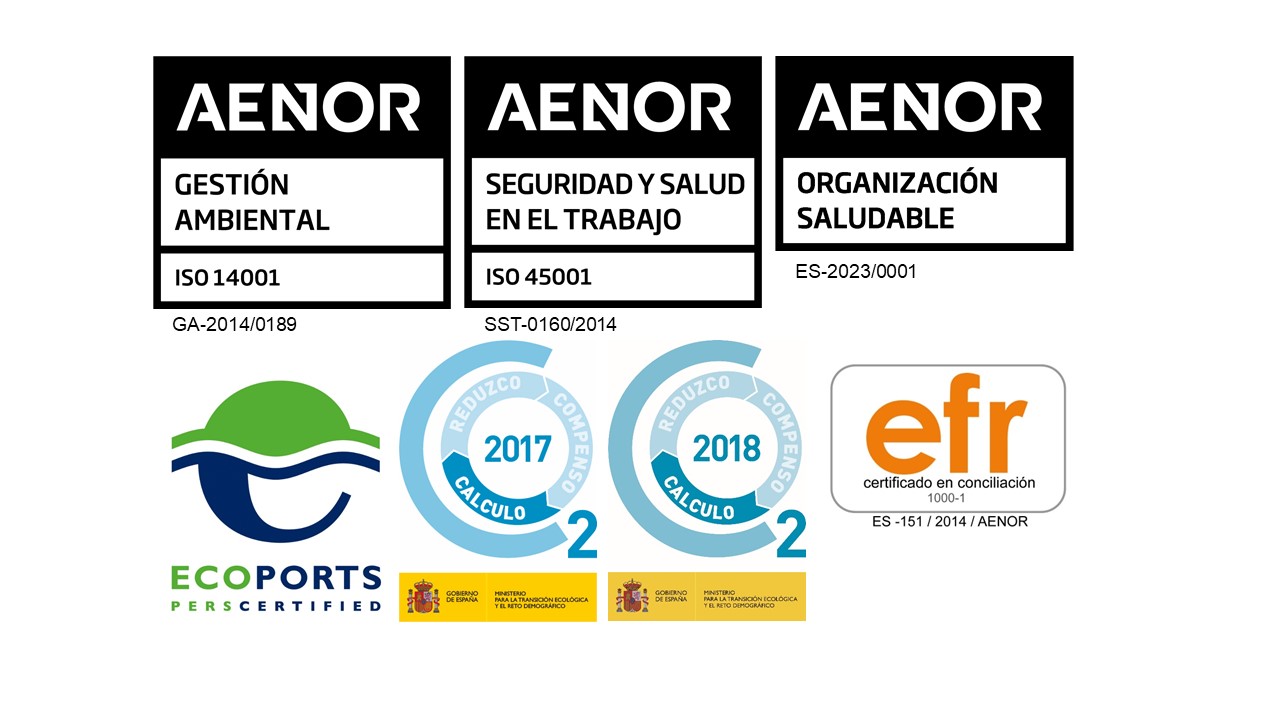Passenger Terminals
Maritime Station of Santa Cruz de Tenerife
The project of the warehouses at the Ribera Quay was designed by Miguel Pintor González in 1950. It had one single outer wall facing the sea of 150 m long, 20 m wide and 6.80 m high, which was linked by its roof to the Avenida de Anaga by means of two 11 m wide bridges. Over the years, it has been remodelled several times, the most important being that of 1990.
In 1992, the conversion works of the old warehouses and the old station began. Small offices (site offices) used by the companies associated with maritime transport were demolished, leaving an operations yard, which gave rise to the so-called “Port-City Building” and officially opened on 30th April 1994 on the occasion of the 5th Centenary of the City and Port of Santa Cruz de Tenerife.
These facilities were designed by the architects Antonio Corona Bosch, Arsenio Pérez Amaral and Eustaquio Martínez García.
Offices for shipping companies, operation and port services are located in the “Port-City Station”. This Maritime Station provides services for inter-island and domestic passengers.
Maritime Station of Santa Cruz de La Palma
The present maritime station was built using the first existing structural warehouse and placing the construction below the same, which did prevent the execution of structural works and reduced costs. The outside enclosure of one of the structural warehouses was thus carried out. Its metallic structure has a rectangular shape and consisting of a single storey, which uses the mezzanine for offices. Ticket offices are located in the nearest entrance to the city and the central area provides toilets, newsstand, bar and waiting area.
The construction of this first Maritime Station began in 1999 and officially opened on 30th June 2000 on the occasion of the Bajada de la Virgen.
The same reason was also elected for expansion’s implementation, acting on the following structural warehouse and linking both by means of an interconnection building of new construction.
In the structural warehouse, consisting of a single storey, are located the Port Police office, dressing rooms for employees and user’s toilets. The two-storey interconnection building provides more offices, both for the Port Authority, concession holding companies and port traffic control.
This new structural warehouse has a total floor area of 873.48 square metres and the interconnection building is 678 square metres.
After expansion works were completed, the Port of Santa Cruz de La Palma has a maritime station with a useful area of approximately one thousand six hundred square metres.
Maritime Station of San Sebastián de La Gomera
The initial draft project of the Maritime Station of San Sebastián de La Gomera was made by the architect Carlos Schwartz Pérez and approved on 2nd March 1998 with a PTA 106 million budget.
As a consequence of the successive changes and extensions carried out in the Port of San Sebastián de La Gomera, the Port Authority has recently remodelled and expanded the Maritime Station, partly because the increase of the present station users and shipping companies together with port service providers.
To all of this we should add preventive measures that, according to the ISPS Code (International Ship and Port Facility Security Code), are the minimum-security arrangements for people and luggage using the station as an entry and exit door of La Gomera.
Expansion and improvement work consisted of making a pedestrian corridor for any future processing involving elements from the station to the pedestrian boarding corridor, adapting to the international safety measures.
The Maritime Station has dressing rooms and bathrooms for Port Authority employees, billing systems and a baggage hall prepared for checking, as well as a 375-people pre-shipment room with its corresponding services. It has a room specially designed for the Maritime Traffic Control Centre as well.
Maritime Station of La Estaca, El Hierro
The project of warehouses and dwellings in the Port of La Estaca on the island of El Hierro was draft in 1949 given the need to have a house for the port security guard and warehouses for port operations. The building was built in the area of the quay expansion, the only building land in the immediate vicinity. The ground floor was intended to offices and warehouses, and the other floor divided into two to the port security guard’s house and workplace.
It is a two-storey building and the construction began in 1950 with a PTA 363,196.66 budget.
In 1991, the Board of the government agency Puertos del Estado in Santa Cruz de Tenerife carried out the dwellings and warehouse repair work at the harbour. Its proximity to the sea has caused serious damages in the building, so a maintenance work was conducted and a new lighting, carpentry and furniture were placed. The works lasted for five months and had a PTA 13,457,393 budget.
In 1992, in order to provide a better service for port’s users, a building of one million pesetas was built. The works consisted of the construction of two establishments on a single storey placed at the entrance of the port breakwater. One is intended to a waiting room and cafe, and other to service site offices and port employees.
After completing expansion and remodelling works at the harbour in 2005, the Port Authority of Santa Cruz de Tenerife decided to have new premises built with a floor area of 2,333 square metres on four floors consisting of a cafe, shipping lines offices, port and police control, among others.
The Maritime Station is located at the entrance of the dock and is adapted to the International Ship and Port Facility Security Code (ISPS Code). The building is characterised by being singular so much in shape as in development.
On the back, with the façade towards the dock, there is a general ramp for passenger arrivals and a direct access to the baggage hall. To the north, with the façade towards the mountain and on two floors, there is an office module for shipping lines, port police, luggage registration and offices for Terminal’s own use. To the south, and differentiated with an exempt module, there is a cafe connected to the building through a walkway.






